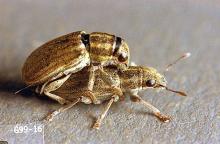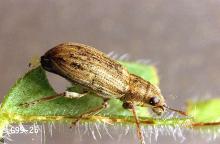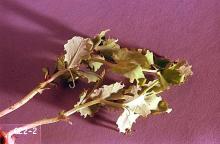Sitona lineatus
Pest description and crop damage Adults are grayish brown weevils about 0.16 inch long with three faint stripes on the thorax. They appear in large numbers in spring and sometimes late summer.
Adult feeding occasionally can cause substantial defoliation, which is of most concern on seedling stands. Pea leaf weevil adults migrate in large numbers when other crops they are infesting are harvested. Their presence in fields is usually spotty, and targeted treatments at field margins can be very effective. For additional information, please see: https://agresearch.montana.edu/wtarc/producerinfo/entomology-insect-ecology/PeaLeafWeevil/AlbertaFactSheet.pdf.
The following insecticides are hazardous to bees and should not be used if bees are foraging in the alfalfa.
Management-chemical control
- alpha-cypermethrin (Fastac EC) at 0.014 to 0.025 lb ai/A. PHI 3 days of cutting or grazing. REI 12 hr. Retreatment interval 7 days. Do not exceed 0.025 lb ai/cutting and 0.075 lb ai/A per season. (Group 3A)
- beta-cyfluthrin (Baythroid XL) at 0.0065 to 0.0125 lb ai/A. PHI 7 days for grazing or cutting. REI 12 hr. Retreatment interval 5 days. Do not exceed 0.044 lb ai/A per cutting or 0.175 lb ai/A total per season. (Group 3A)
- chlorantraniliprole/lambda-cyhalothrin (Besiege) at 0.059 to 0.088 lb ai/A. PHI 1 day for forage and 7 days for hay. REI 24 hr. Minimum of 5 days between applications. Do not exceed 0.12 lb ai of products containing lambda-cyhalothrin or 0.2 lb ai of chlorantraniliprole-containing foliar products per acre per growing season. Refer to product labels for application limits if products containing gamma-cyhalothrin and products containing lambda-cyhalothrin are to be used in the same season. (Group 28 and 3A)





